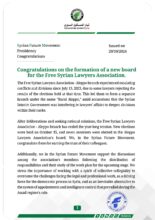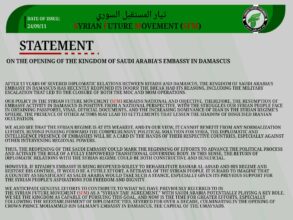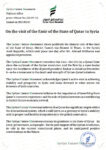Migration and Refugee Crisis: A Question of the Structural Dynamics of the Global System

Introduction:
Henry Kissinger and Noam Chomsky offer diverging perspectives in their books on the new world order. While Kissinger provides an in-depth view from a historical and geographical angle, Chomsky presents a social and economic outlook from his leftist perspective. However, both agree on the issue of human disparities and the necessity to overcome their dangers. Chomsky, in particular, warns more emphatically about the economic disparities between the rich and poor in America first, and between America and the rest of the world second.
Indeed, the new world order, which for Kissinger started with the Peace of Westphalia and for Chomsky with the fall of the Soviet Union, today suffers from significant tremors. These are evident in the Ukraine war, the rise of China, and the Gaza conflict. Yet, these tremors manifest most significantly in the refugee crisis, as people flee from conflict-ridden regions to the developed West. By mid-2023, the global refugee count reached 36.4 million—an increase of 3 percent (1.1 million people) from the previous year. By the end of June 2023, approximately 110 million people were forcibly displaced from their homes due to persecution, conflict, violence, human rights violations, and events seriously disrupting public order, according to statistics from the United Nations High Commissioner for Refugees, which generally underrepresent the true extent of the crisis.
This contemporary seismic activity rests on two pillars:
- Multiple Border Conflicts:
- The border conflict between Sudan and Ethiopia.
- The border conflict between Eritrea and Ethiopia, which escalated into a war over the “Badme Triangle” from 1998 to 2000.
- Not to forget Saddam Hussein’s invasion of Kuwait in August 1990, which significantly altered the regional dynamics through Condoleezza Rice’s policy of creative chaos.
- The Russian-Ukrainian war, which began in 2014 following the Euromaidan protests and the ousting of Ukrainian President “Viktor Yanukovych,” leading to Russian control over strategic locations and subsequent annexation of Crimea, followed by the Donbas protests advocating for separation from Ukraine and joining Russia. The border tensions exploded in 2021 with the buildup of Russian forces, igniting a war that has intensified and continued to this day.
- The threats in the Taiwan Strait in East Asia, which pose a risk of igniting a major war between China and the United States due to U.S. support for Taiwan. This conflict, although draped in sovereignty issues, stems from China’s claim that Taiwan was originally a Chinese province, while the Taiwanese assert they were never part of the modern Chinese state formed for the first time after the 1911 revolution or the People’s Republic of China established in 1949.
- Authoritarian Conflicts due to a desire by one party within a single country to monopolize power:
- The conflict in Syria, which began in 2011 and continues without a foreseeable resolution, complicated by the intervention of two regional powers (Iran and Turkey), and two global powers (the United States and Russia), resulting in the Syrian map being divided into four zones of influence, each with an independent government needing only international recognition to become four separate Syrian states.
- The conflict in Sudan, revolving around leadership within the military, between the commander of the armed forces and de facto president Abdel Fattah al-Burhan, and his deputy, the commander of the Rapid Support Forces, Mohamed Hamdan Dagalo (Hemedti).
These conflicts can be a mix of border-related and power-related issues, as seen in the Gaza war, which suffers from an occupation rejected by Palestinians, in addition to a power dispute between Gaza and the West Bank, as well as the war in Yemen.
So, What is the Solution?
Unfortunately, there is no current solution within the international system, which has failed to achieve global peace and security. Wars are increasing, the use of dangerous weapons proliferates, and conflicts intensify, posing a greater danger to the entire world. According to the Heidelberg Institute for International Conflict Research, in 2018 compared to the previous year, the number of “limited wars” increased from 16 to 25, where “limited” denotes a measured confrontation in which the belligerent parties do not use all available means.
On the other hand, the refugee crisis and the flight from unhappy to safe, developed countries cause an increase in racism and right-wing extremist thought, exemplified by the German Pegida movement, founded in late 2014. United Nations reports have confirmed this trend, including the UN Human Rights report issued in August 2020 titled, “Contemporary forms of racism, racial discrimination, xenophobia, and related intolerance.”
It can be argued that continuing to enforce human rights laws is beneficial currently to mitigate harm, but the world needs a real solution
, and the true solution lies in addressing the root causes of the problems, not just their symptoms. In the case of migration and refuge, Asaad Abdel Hussein Khnjar in his book on illegal immigration believes that there are determinants that have contributed to shaping diverse policies governed by both objective and subjective conditions. Among these objective conditions—according to him—is that these migrants did not have legal status (legitimacy) that granted them the right to enter a particular country, especially since some of them might be accused of undermining the national security of the host countries due to their association with racist groups. The subjective conditions lie in that most of these migrants are from the Middle East and North Africa, which serves as a reminder to European governments of the stereotype they have formed about the Islamic East.
Therefore, to solve the crisis of migration and refuge that is ravaging the structure of the global system, it is necessary to resolve both border and power-related conflicts worldwide, but five reasons show the impossibility of finding solutions to these conflicts within the structure of the current global system:
- The arms trade, which generates substantial profits for states, companies, and businessmen.
- The threat of nuclear weapons.
- Migration itself, which will cause continued conflict and allow the belligerents to influence major powers to gain authoritarian benefits.
- The competition among great powers, which smaller countries exploit to their advantage in the margins of their conflicts.
- Poverty and economic disparities.
Thus, realistically, the contemporary global system lacks the capacity to stop conflicts, and therefore, it cannot resolve the migration and displacement crisis except by conflicting with refugees, or by contravening the structure of the existing global system based on UN laws that allow free movement and the right to protection for the oppressed and those fleeing conflicts.
But What Can Be Done?
Within the structure of the global system, it is only possible to mitigate the impacts of conflicts and apply human rights laws, albeit minimally, although violations will increasingly occur over the years, as it seems. Thus, a significant burden will fall on civil society, human rights advocates, humanitarians, and ethicists in trying to establish what can be solidified of human rights laws.
Philosophy of the Solution:
As previously mentioned, it seems impossible to find final solutions to the migration and refugee crisis within the same structure of the global system, due to the inability to stop conflicts that will either increase or continue in some form. However, this study proposes a final solution based on the inevitability of evolving the concept of citizenship.
The concept of citizenship, which began primitively with freemen and warriors, eventually moved to being linked with the nation-state concept with Jürgen Habermas. He asserted that nationalism is not necessarily linked to the nation; rather, it is linked to specific social institutions and values. Habermas moved beyond the nation-state model to build European citizenship, then to the emergence of a contemporary concept of “global citizenship,” which began to be embraced by international organizations such as UNESCO (which published a book in 2015 titled “Education for Global Citizenship: Themes and Learning Objectives”).
The final solution to the refugee crisis appears to lie in changing the structure of the contemporary global system towards a broader horizon based on establishing “global citizenship” or a single global state, and a single human nation that nurtures human diversity and does not make it conflicting, and which prevents any authoritarian conflict, whether between warlords in different countries or between regimes and their people, through global laws imposed across the Earth. The real remedy, it appears, lies in global citizenship and the establishment of a global governance that opens borders between people and ends the existence of authorities that control homelands.
No doubt, this solution is difficult and far-reaching, but it is the only comprehensive solution. Despite all efforts to solve the migration and refugee crisis within the contemporary system, the results will not be final, nor will they be effective.
However, the future seems to lie with this option, which will become a reality for all humanity and the custodians of the contemporary global system in two cases:
- The development of technology that allows humans to travel and move within advanced and autonomous monitoring programs, by land, sea, and air. Although the state, according to Marx, monopolizes the means of production, and with Max Weber, it monopolizes violence, according to John Torpey, it monopolizes the means of movement. However, the events of September 11, according to Eli Zaretsky and Mark Salter in their books “On Surveillance and Security at the Global Level: Borders and Security and Identity,” represented a practical orientation towards quashing hopes of a borderless world. Yet, with the emergence of multiple migrations by land, sea, and air at times, borders have become more fluid, to the extent that some travel alone with only a smartphone connected to their phone’s map, to the point where some literature refers to “Soft Borders” or loose ribs or parts out of control, where traditional literature in security and border management studies relied on the concept of “Hard Borders,” defined as “the dividing line between the economic, political, cultural, demographic, and social borders of two different countries, where the sovereignty of one state begins and the sovereignty of another ends.”
With the current state of travel tools being a bit complicated, but with a near future in which technology seems closer and closer to facilitating individual travel, whether via small individual planes or boats with a safer and cheaper security system, we will be faced with a significant possibility of abolishing the role of borders in the face of this promised development. - The development of programming to the extent of creating a unified global language or the ability to instantly translate for every person, like the Camb.AI project in the United Arab Emirates, which developed innovative technology for instant voice translation based on generative artificial intelligence to dub the voices of a group of global athletes into more than 100 languages and dialects.
If humanity reaches this level, then no authority can control its people by force and coercion, nor can any developed country prevent people from entering it, and thus humanity will face two possibilities:
Either make all homelands authoritarian based on dictatorial military rule that shares war or peace.
Or make all homelands democratic capitalist or at least have a unified economic welfare, and therefore there will be no reason for mass migration and refuge to change the original country due to the similarity of authority in all countries.
No doubt, the first possibility means wars that will not end and revolutions that will not stop, which leads us to favor the second possibility no matter how long it takes.
This is the possibility that will be closer to a reality that supports and helps establish global citizenship.
Therefore, until we await the development of technology and programming, it is incumbent upon the wise of humanity to strive to lay the groundwork and legalize global citizenship, preach about it, advocate for it, and work on it to make it the post-new global system.
Thus, humanity takes a positive step towards overcoming reality, which will inevitably impose global citizenship, and provide a real solution to the problems of the global system, especially the problem of migration and refuge.
Jomaa Mohamad Laheep
Research and Studies Department
Studies
Syrian Future Movement (SFM)
References:
- Henry Kissinger, “World Order: Reflections on the Character of Nations and the Course of History,” translated by Ashraf Radi, Treasures, 2015.
- Noam Chomsky, “The Old and New World Order,” translated by Atef Abdel Hamid, Nahdet Misr, 2007.
- Asaad Abdel Hussein Khnjar, “Illegal Immigration and its Reflections on the Political Systems in Europe,” Al-Arabi Publishing, 2022. 178.
- Eli Zaretsky and Mark B. Salter, “Surveillance and Security on the Global Scale: Borders, Security, and Identity,” translated by Imad Sheiha, Arab Center for Research and Policy Studies, 2021.
- Mid-Year Trends Report | UNHCR (unhcr.org)
- Border Conflicts and Their Impact on Stability in the Horn of Africa: The Sudanese-Ethiopian Border as a Model (afrocen.org)
- Russia and Ukraine: What’s the Reason for the Crisis Between the Two Countries? – BBC News Arabic
- The Full Story Behind the Chinese-Taiwanese Conflict (aawsat.com)
- A/75/329: Contemporary Forms of Racism, Racial Discrimination, Xenophobia, and Related Intolerance | OHCHR
- Why Are Conflicts Increasing in the World? Five Nobel Laureates Answer – DW – 09/27/2019
- Education on Global Citizenship: Themes and Learning Objectives – UNESCO
- Future Center – The Intractable Problems of Border Control in the Middle East (futureuae.com)
- What Will Future Modes of Transport Look Like? – BBC News Arabic
- Instant Translation with Artificial Intelligence.. Exciting Innovation by a Startup Company in the UAE (al-ain.com)





